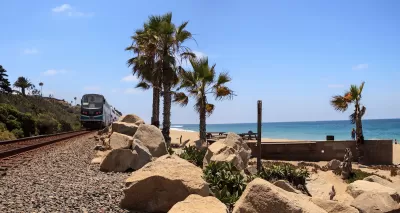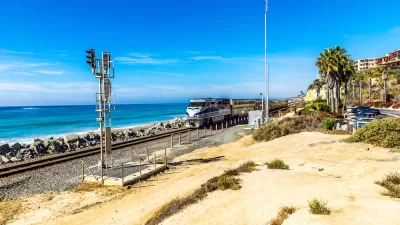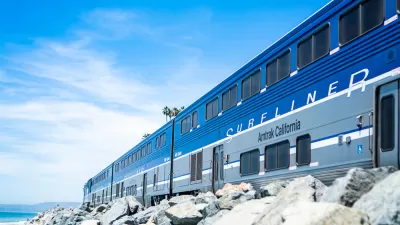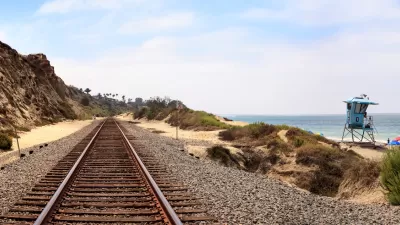Coastal erosion and rising sea levels threaten one of the nation’s most scenic—and strategically important—rail corridors.

The coastal rail corridor between San Diego and Santa Barbara faces growing risks from coastal erosion and climate change, according to a California Senate Transportation Subcommittee. As Phil Diehl explains in The San Diego Union-Tribune, “Landslides and cliff collapses have periodically stopped the trains in Del Mar and San Clemente, and many other places also need improvements and protection from sea-level rise along the 351-mile Los Angeles-San Diego-San Luis Obispo corridor.” Yet the corridor provides a crucial transportation link for passengers, freight, and military transportation.
According to a Senate report, the cost of making safety improvements to the Los Angeles-San Diego-San Luis Obispo (LOSSAN) corridor could be more than $20 billion. With seven different right-of-way owners, the corridor is a complex system with little precedent in the United States. Researcher Genvieve Giuliano says a long-term solution would be “to create a single statewide agency that would fully integrate the multiple agencies that provide the separate passenger services — Amtrak, Coaster and Metrolink.”
Farther up the coast, the state’s Department of Transportation (Caltrans) recently completed its first erosion mitigation project for a roadway, moving a highway segment 400 feet to protect it from landslides.
FULL STORY: Climate change imperils San Diego County’s coastal rail corridor, panelists say

Maui's Vacation Rental Debate Turns Ugly
Verbal attacks, misinformation campaigns and fistfights plague a high-stakes debate to convert thousands of vacation rentals into long-term housing.

Planetizen Federal Action Tracker
A weekly monitor of how Trump’s orders and actions are impacting planners and planning in America.

In Urban Planning, AI Prompting Could be the New Design Thinking
Creativity has long been key to great urban design. What if we see AI as our new creative partner?

How Trump's HUD Budget Proposal Would Harm Homelessness Response
Experts say the change to the HUD budget would make it more difficult to identify people who are homeless and connect them with services, and to prevent homelessness.

The Vast Potential of the Right-of-Way
One writer argues that the space between two building faces is the most important element of the built environment.

Florida Seniors Face Rising Homelessness Risk
High housing costs are pushing more seniors, many of them on a fixed income, into homelessness.
Urban Design for Planners 1: Software Tools
This six-course series explores essential urban design concepts using open source software and equips planners with the tools they need to participate fully in the urban design process.
Planning for Universal Design
Learn the tools for implementing Universal Design in planning regulations.
Gallatin County Department of Planning & Community Development
Heyer Gruel & Associates PA
JM Goldson LLC
City of Camden Redevelopment Agency
City of Astoria
Transportation Research & Education Center (TREC) at Portland State University
Jefferson Parish Government
Camden Redevelopment Agency
City of Claremont





























